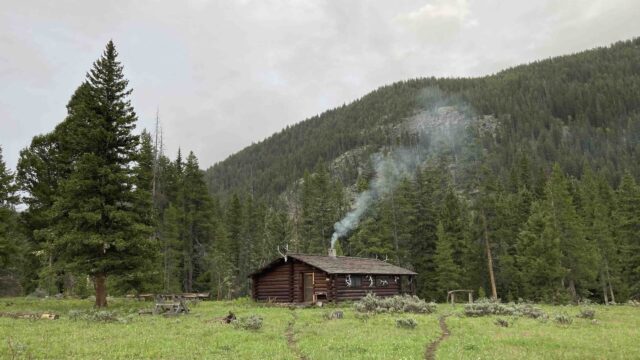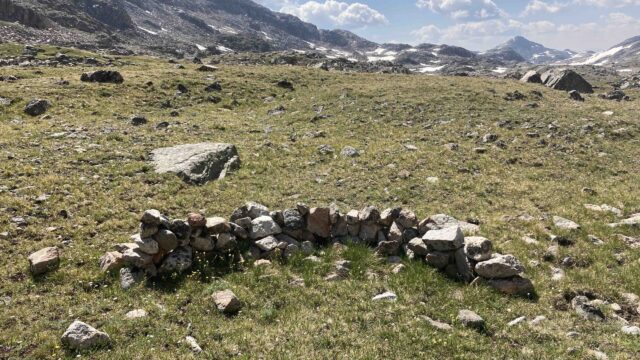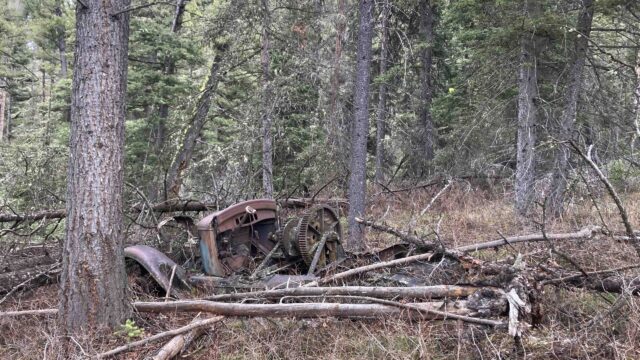Wilderness Has a Purity Problem

This essay on the contradictions of pristine wilderness is the eighth and final piece in the Unpure Imagination series, which seeks to engage with and challenge themes of toxicity, purity, pollution, and restoration in an always compromised world. Series editors: Ben Iuliano, Kuhelika Ghosh, and Richelle Wilson.
The notion that national parks and wilderness areas in the United States are constructed spaces that perpetuate colonial harms on people and land is not new. The public is increasingly aware that not only have these landscapes been shaped by Indigenous peoples over millennia, but also that these spaces themselves are unique products of our politico-economic system—the nature within their boundaries is neither pristine nor natural.
As a former student and a current employee of the U.S. Forest Service, I’ve learned, read, and thought about these issues extensively. As a white European settler in this country, I’m very concerned with how we can make our public lands more accessible and equitable, and how they can engender better human–environment relationships. I feel hyperaware of the problems, both ideological and material, with our public lands. Yet at the same time, national parks and wilderness areas are where I have always turned for refuge, joy, and meaning. I’m a bit extreme in my love for the outdoors, which is why working for the Forest Service in a wilderness area appealed to me in the first place, but I’m by no means unique—so many people get the same joy and meaning from public lands despite awareness of their contradictions and issues.
The tension between these ideas about federally protected lands—between what I feel and what I know—is something I think a lot about, especially when I’m at work. As part of my job on a backcountry trail crew, I get to spend days at a time deep in the Rocky Mountains. We take day trips, we backpack, we stay overnight in cabins. We often go days without seeing or hearing another person outside of our crew—it’s just us five humans amid the valleys, ridges, pine trees, grizzlies, and countless other wilderness creatures we rarely see. Despite grueling 10-hour days of hiking and crosscutting trees, I feel such peace and calm in the wilderness. The mountains and forests never fail to bring me wonder, curiosity, and serenity. On my days off, I go backpacking on my own, often deliberately visiting less popular areas to increase the odds it’ll be just me and the woods. To say I love the mountains is a vast understatement.
I have immense trouble reconciling these feelings with my knowledge that these areas are constructed, are not natural per se, are not pristine. I love not seeing any other people on a multiday backpacking trip. I love that in the wilderness you can’t use motorized equipment of any sort, so I don’t hear chainsaws or mountain bikes or cars. There are huge fire scars where blazes started by lightning burned without human interference. All these things are in a way parts of a “pristine” nature—a landscape untouched by contemporary American infrastructure.
What would impurity look like in wildernesses?
But is this landscape really untouched by humans? There is a trail even 25 miles from the parking lot, and my job is to keep the path clear. Humans built these paths and continue to maintain them. My coworkers and I occasionally stay in cabins in the backcountry; even though they were constructed decades before my parents were born, they did not spring from the earth on their own. There are remnants of the farming and shepherding by settlers that occurred before the area was designated as wilderness—nature does not create square pastures or rusty plows. And if we go back more than a few centuries, there are any number of rock quarries, meadows, caves, cliffs, and other features used and created by Indigenous peoples over the millennia—certainly none of those are untouched by humans. Even the “natural” fire scars are evidence of Forest Service policy: decades (centuries, really) of complete fire suppression have resulted in forests full of dry fuel that burn larger and hotter than fires have on this continent for millennia.
The mountains that I adore are only pristine, only “pure nature,” if I exclude the numerous bits that humans have, fairly obviously, built or managed. Furthermore, my job is to help reify—with human intervention—the very “purity” of the landscape in whose constructed naturalness I myself and others then revel. The parameters of what I do are dictated by both legislation and strong cultural beliefs about the definition and value of “pure nature”; in this way, recounting the myth of pristine wilderness is one example of what Alexis Shotwell calls purity practices: “productive normative formulations [that] make a claim that a certain way of being is aspired to, good, or to be pursued.” Certain ways of traversing the wilderness are acceptable (backpacking, horse packing, hiking) and others are not (ATVing, mountain biking). Some ways of being (fly-fishing) are deemed more pure than others (mining).
Delineating ways of being in wilderness from non-wilderness helps reinforce the notion that we need separate, bounded spaces for nature and people. The two are only allowed to intermingle so much. We imagine that in bolstering their separateness, we are keeping both more pure and good. Wildernesses are how we separate and order a messy world; they are a way for us to parse what is culture and what should stand outside. Yet we settlers only create bounded spaces for nature because we’ve gutted the rest of the landscape that we haven’t specifically protected. These land designations are existentially entangled. Upholding their separateness and their individual purities means ignoring that they are cross-contaminated and always have been—neither is purely its own. Wilderness is the necessary corollary to an economic system premised on extraction.
U.S. federal policies enclose these “wild” spaces purportedly to keep some of the landscape and its resources unmarred by contemporary American capitalism. But this enclosure goes further than a simple law or economic ruleset—it is both a symptom and a product of a deeply-held mindset that contends that humans always destroy nature and thus must be kept out. This ideology harkens back to the Enlightenment and the rise of individualism and was extremely influential in the creation of the first national parks. In seeing themselves as corruptors of nature, colonizers assumed no humans could live differently with the land, which necessitated violent removal of Indigenous people from their homes. Racist, expansionist, and genocidal intentions were supported by a settler vision of land as useful only for resources.

The dehumanization of Indigenous people by settlers is well documented, but removal from the land paradoxically necessitated that their humanity be precariously maintained. Cast as a non-human “Other” in many other contexts, here Native Americans needed to be made at least partially human (and thus destroyers of pure nature) to rhetorically justify their removal. They were assimilated into the white settler conception of humanity as impure agents of corruption and destruction while they were simultaneously cast as inferior land managers deserving of exile so the same settlers could visit their “wilderness” in peace.
A century after the first U.S. national parks were created, the Wilderness Act enabled a new category of public land, one to be held to a different, more restrictive standard of use in order to maintain the landscape’s purity. The wording of this act is lofty and noble, but its underlying premise is the same—that (white) people are agents of impurity. Wildernesses were created as a way for settlers to save the world from themselves, based on the premise that contact equates to eternal contamination and with the intention of “recover[ing] a time and state before or without pollution.” Indeed, when I’m in the wilderness, I feel a difference in the amount of so-called human pollution—I’m more attuned to the weather, the soundscape, and the life forms around me. Being in remote spaces brings my attention to things I don’t notice in human-dominated landscapes in a way that certainly feels more pure.
But, as Shotwell says, when we “affirm a commitment to purity [we] glance at the entanglement and co-constitution, the impurity, of everything and . . . pretend that things are separate and unconnected.” We see and experience these landscapes as Edenic, as spaces where the evils of the world and of the federal government (past and present) don’t exist. These landscapes, because we are encouraged to see them as pure, enable us to forget and ignore their sociohistorical contexts. Shotwell reminds us that this forgetting, this “ignorance is not just an absence of knowledge [but] a way to (not) know things.” The (his)stories we are not taught or that we are encouraged to forget about these landscapes are not random. When we see wilderness as pure and ignore its entanglements, we can claim, in the tradition of Ken Burns and Wallace Stegner, that national parks are “the best idea we ever had. Absolutely American [and] absolutely democratic.” Only when we overlook—or indeed, forget, as a “core piece of colonial practice”—all of the racism, violence, and exclusion (both past and present) involved in creating and maintaining these lands can we put them on a pedestal as miraculous.
I am left wondering how to tangibly acknowledge entanglement and co-constitution rather than passively accept the purity of wilderness. Theoretically and mentally I can, but emotionally and physically it’s a bit harder.
Wildernesses are a way for us to parse what is culture and what should stand outside.
In struggling with this contradiction, I ask myself, If what I see now is what I think of as pure, what would impurity look like in wildernesses? In conversations with people around where I work, a binary choice is often implied: either we leave these artificial Edens intact, ignoring their conceptual and material problems, or we scrap the entire concept of protected lands to let people ranch, log, and develop them. Obviously, this is a false binary and there are many other options between these two extremes, but I often find myself succumbing to it when I imagine how these spaces would be changed. The possibility, however vague, that I wouldn’t be able to spend a week in the mountains without seeing another soul, that the spaces I love with my whole being may be encroached upon by logging operations or ATV roads, fills me with dread. I’m sure I’m not alone in this feeling. For many who love these spaces, fear for their loss stems from our commitments to an absolute purity that impede actions for justice on our public lands.
Maybe impurity in these landscapes means more outfitters being permitted to bring people into the often inaccessible backcountry, or more cooperation with local communities and nonprofits. Maybe it means reinstating shepherding in the mountains, or doing prescribed burning in the wilderness. Should it include resuming mining? Where is the line, and who gets to draw it? Increasing access and visitor use may be necessary to inculcate a broad wilderness ethic—how will people recognize that these spaces are worth preserving if they never get to experience them?—but it also comes with difficult questions about how much use is too much use. Figuring out how to tangibly recognize “natural” landscapes as impure without increasing detrimental human impact is an intricate puzzle.

Shotwell writes that to be against purity means to disavow “the rhetorical or conceptual attempt[s] to delineate and delimit the world into something separable, disentangled, and homogenous.” Acknowledging that the wild spaces I love are themselves part and parcel of the “modern world” from which I seek refuge will be a never-ending project, both intellectually and emotionally. As I trammel the purportedly untrammeled wilderness this summer, I’ll be struggling with this contradiction yet again and can only hope that the vast landscapes will give me the mental clarity I need to see them as the entangled and co-constituted space they truly are.
Featured image: remnants of old farming equipment in a U.S. National Park. Photo by Ande Peersen, 2021.
Ande Peersen works on a U.S. Forest Service trail crew. Website. Contact.






You must be logged in to post a comment.